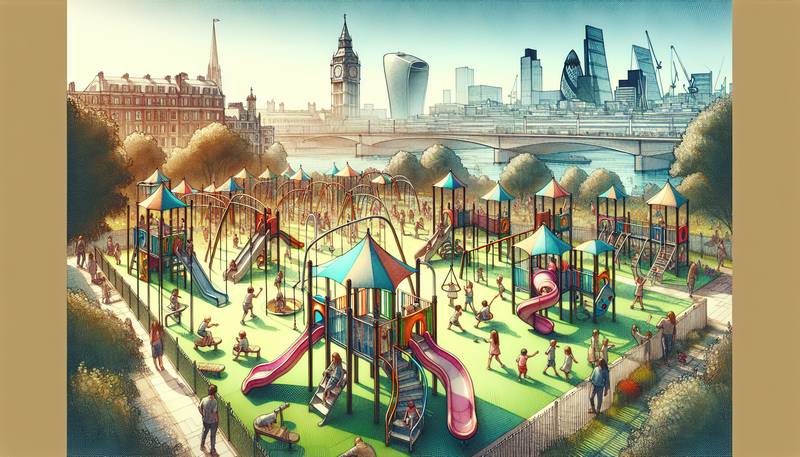The Peculiarities of Children's Playground Design and Its Impact on Development

Playgrounds: The Land of ImaginationThe world of playground design is something to behold, where swings become spaceships, and slides transform into high-speed highways. Each piece of equipment is carefully structured to ignite a child's imagination—though, if you ask any parent, it might also ignite their sense of panic every time Junior decides that the top of the slide is a good place for a breakdance. Playgrounds are these magical lands where splattered ketchup from the snack bar becomes an abstract work of art, and the gravel on the ground is just an exciting new ingredient in the sandcastle-building competition. With brightly colored structures reaching for the sky, they invite kids to leap into adventures, often resulting in a few grass stains along the way. The Science Behind the SwingSwing sets provide a unique case study in design. They swing through the air, allowing children to defy gravity—at least momentarily—before they come crashing back to earth. But there's more to it than just the thrill. The back-and-forth motion is a great way for little ones to experience kinetic energy in action. Consider it a physics class without the boring textbooks or tests. Research has revealed that swinging can even help develop a child’s core strength and balance. Additionally, it promotes hand-eye coordination as kids learn to pump their legs and control their speed. And let's be honest: watching a child swing is like watching a mini superhero in training, working hard to master their flight skills.Creative Climbing StructuresClimbing structures are often the most popular feature on playgrounds, acting as the Everest of childhood. Kids can be seen scaling these structures as if their future depends on it; perhaps they dream of becoming professional mountain climbers, or maybe they just really want to see their parents’ expressions when they spot them halfway to the top.Not only do climbing frames enhance physical strength, they also cultivate problem-solving skills. Figuring out which way to go next is akin to navigating a labyrinth—or a complicated IKEA assembly without the instructions. Different levels of difficulty cater to various age groups, so that toddlers can find their footing while older kids channel their inner Tarzan.The Balanced PlaygroundBalancing is not just for tightrope walkers. Balance beams and other challenging equipment help children develop crucial stability and coordination skills. Imagine a world where toddlers effortlessly navigate the beam like it's a stroll in the park—well, until they remember that walking can also involve running and jumping, often leading to a hilariously ungraceful tumble.Kids learn about risk assessment here: Should they leap off the beam and risk skinned knees, or play it safe and take the long route? These moments, though fraught with the potential for scraped elbows, ultimately teach them resilience. A tumble on the balance beam might be the smallest of life’s lessons, but it's one they'll carry with them into adulthood—hopefully minus the bruises.Inclusive Designs: Everyone Gets a TurnOne of the most significant trends in playground design is inclusivity. No longer are playgrounds a domain reserved for the spry. Designers now incorporate equipment that accommodates children of all abilities, making sure that everyone gets a chance to make their own mess and maybe even find a future playmate—or at least an accomplice in mischief.This approach is more than just a tick in a box; it's a vital step toward fostering empathy and understanding among kids. When they share space and play together, they learn important social skills, like how to take turns and strategies for negotiating who gets to spin the merry-go-round. And let's be real; nothing brings kids together like a heated debate over who’s going to get that last swing.Playtime: Where Learning HappensIt's easy to overlook the educational value of play, but the truth is, playgrounds are classrooms in disguise. Play is a child's primary way to experiment with the world around them, whether that means tackling social skills or basic physics by launching themselves off a swing. While adults interpret these moments as chaos, children find valuable lessons in every tumble and triumph.So, next time parents find themselves breathing into a paper bag while watching their kids charge toward the monkey bars, they could take a step back and appreciate the chaos. In this whirlwind of laughter and skinned knees, kids are becoming the next generation of thinkers, creators, and, yes, perhaps even future tightrope walkers. Playgrounds: The Real MVPs of DevelopmentAs the day winds down and little ones are ushered off the playground with dirt-streaked faces and wild hair, it's easy to see that their adventures have equipped them with more than just endurance. They leave with newfound friendships, boosted confidence, and stories that will likely embellish as they grow older. Playgrounds might just appear as simple structures made of wood and metal, but their impact on development is anything but basic. They stand as the unsung heroes in the journey of childhood, reminding us that learning can indeed be a slippery slope—while also being a whole lot of fun!
|
|







